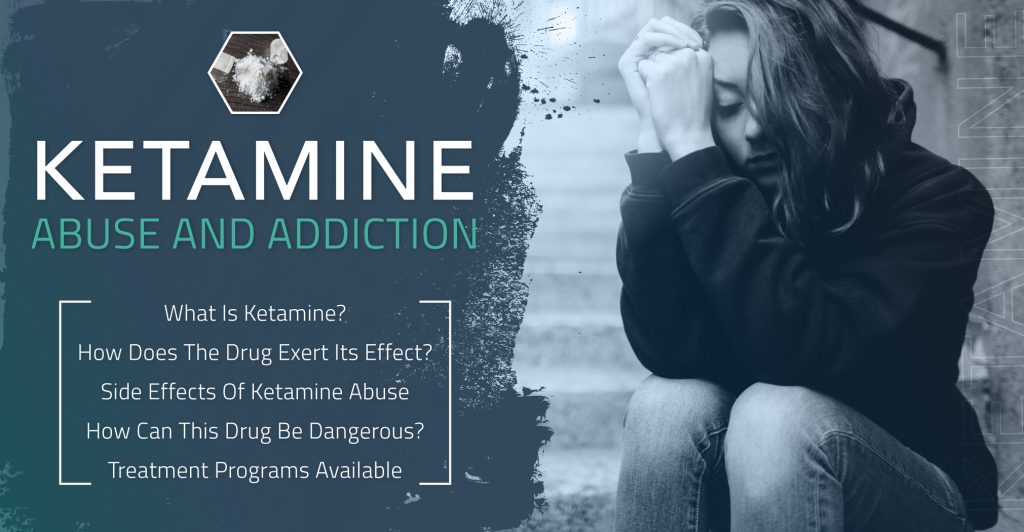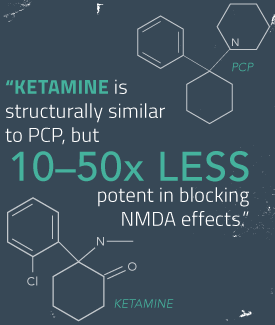
When on the hunt for a high or a drug-induced pleasurable experience, drug abusers will often go to great lengths to feel this way, including using a drug that is used on animals. Though ketamine may also be used in human medical applications, this sheer fact offers us a frightening perspective into this use and abuse.
What Is Ketamine?
 Developed in 1962, ketamine, known under various street names, such as Special K, Vitamin K, KitKat, and Cat Valium, is a dissociative anesthetic used in medical applications for human and veterinary purposes, albeit in the human cases, much more rarely. Further, the National Highway Traffic Safety Administration (NHTSA) notes that it is also considered within the drug classes hallucinogen and psychotomimetic (inducting symptoms similar to psychosis, including delusions and delirium). This sense of disconnect may entail altered auditory or visual perceptions (hallucinations) and a sense of losing control.
Developed in 1962, ketamine, known under various street names, such as Special K, Vitamin K, KitKat, and Cat Valium, is a dissociative anesthetic used in medical applications for human and veterinary purposes, albeit in the human cases, much more rarely. Further, the National Highway Traffic Safety Administration (NHTSA) notes that it is also considered within the drug classes hallucinogen and psychotomimetic (inducting symptoms similar to psychosis, including delusions and delirium). This sense of disconnect may entail altered auditory or visual perceptions (hallucinations) and a sense of losing control.
The Center for Substance Abuse Research (CESAR) elaborates on this, noting these properties are a bit different, in that the drug “has been known to produce illusions or hallucinations that are enhanced by environmental stimuli.” For these reasons, for the past several decades, this drug has been abused recreationally, oftentimes at raves. Due also to these qualities, the Drug Enforcement Administration notes that it is similar to phencyclidine (PCP). However, in comparison to other drugs of this nature, such as PCP and LSD, ketamine has a shorter duration, with the “trip” lasting only a half hour to an hour as opposed to several.
When this drug is used illicitly, it is typically abused in one of two forms, either as a liquid or a powder, though it may also be available in crystals, capsules, tablets, and solutions. The powdered form is actually produced by dehydrating the liquid, as that is how it is produced for the pharmaceutical applications. Ketamine abusers typically chose to snort the drug in amounts termed “bumps,” however, they may also mix the powder in a drink and consume it orally, smoke it, inject it, or even administer it rectally. In addition to the pharmaceutical grade ketamine that users abuse, the DEA reports that some of the greatest quantities of illicit Ketamine in the United States come from Mexico.
Aside from using it in its pure form, users may seek this drug, or even use it unknowingly, when it is mixed with various other drugs, including heroin, cocaine, amphetamine, methamphetamine, carisoprodol, or MDMA, as referenced primarily from the DEA. In addition, in some circles, tobacco cigarettes or marijuana joints are laced with this drug and smoked.
How Does The Drug Exert Its Effect?
Despite its presence as both a medical and recreational drug for several decades, researchers are still striving to understand the way in which this drug works. A 2014 Trends in Anesthesia and Critical Care article asserts that “Ketamine has been in clinical use for over half a century, yet its precise mechanisms of action remain mysterious for the large part.” They do continue, however, to describe ketamine’s hallmark state of dissociative anesthesia, as that which includes the psychotomimetic characteristics we discussed earlier; at high concentrations, a person becoming highly sedated or unconscious; inducing an absence of pain, and a heightened state within the sympathetic nervous system, which is responsible for activating your body’s fight or flight response.

Beyond this, like most every drug of abuse, ketamine changes the way dopamine an important neurotransmitter within your brain functions. Though not an opioid drug, the NHTSA notes that the analgesic (pain relieving) and dysphoric states obtained during ketamine use may be due to the way the drug influences opiate receptors. Non-competitive NMDA receptors may also be antagonized in a way that produces the analgesic effect. This effect contributes in part to ketamine’s similarity to other drugs; as the NHTSA details, “Ketamine is structurally similar to PCP, but 10-50 times less potent in blocking NMDA effects.”
Side Effects Of Ketamine Abuse
Like other drugs of abuse, the time to peak effect of this drug is dependent on the way a person chooses to administer it. As outlined by CESAR, this is as follows “injection generally takes between 1 and 5 minutes; snorted ketamine between 5 and 15 minutes; and oral ingestion between 5 and 30 minutes.” This drug creates a variety of physiological and psychological side effects, such as:
- Slurred speech
- Dizziness
- Vomiting
- Sedation
- Amnesia
- Feeling like you’re floating
- Sense of dreaminess
- Decreased cognition and increased confusion
- Feeling helpless
- Flashbacks
- Rigid muscles
- Poor motor functions
- Out-of-body experiences
- Becoming easily distracted
- Feeling invulnerable
- Sense of disorientation
- Agitation
- Hallucinations
- Delirium
- Paranoia
What is interesting and of concern for those who abuse this drug, is that despite the fact the sense of hallucination wears off in less than one hour, a person may yet be impaired for up to 24 hours; specifically, that they may have impaired coordination and judgment and continue to experience alterations to their sensory experience within this time, elements that could amount to dangers, given certain situations, such as those which induce heightened risk of injury.
How Can This Drug Be Dangerous?
Despite the fact that this drug does continue to have limited medical applications, the safety factor drastically changes when it is abused. Within situations of abuse or addiction, a user may face the following dangers:
- Damage to episodic and working memory
- Anxiety
- Cataplexy (muscle weakness and loss of voluntary muscle control)
- Nystagmus (random and uncontrollable eye movement)
- Dystonia (involuntary and abnormal muscle constrictions)
- Ulcerative cystitis (creates pelvic and bladder pain and more frequent urination)
- Cardiac concerns, such as increased blood pressure, tachycardia, chest pain, and palpitations
- Injection drug users face risk of infectious diseases from shared needles
- Psychosis
- Symptoms comparable to those associated with schizophrenia
- Aggressive and violent behavior
- Respiratory depression
- Seizures
- Overdose which may result in death
 Of particular concern, noted by CESAR, is a combination of side effects that create an enhanced state of vulnerability for the victim, including impaired vision, weakness, lack of coordination, and the intense sense of helplessness and confusion. Together, these effects may lead to various crimes committed towards the user, including date rape. They caution us of another risk, termed a “K-hole,” that may occur after a user consumes large amounts of the drug. This time is “reached when the user is on the brink of being fully sedated and is likened to an out-of-body or near-death experience.”
Of particular concern, noted by CESAR, is a combination of side effects that create an enhanced state of vulnerability for the victim, including impaired vision, weakness, lack of coordination, and the intense sense of helplessness and confusion. Together, these effects may lead to various crimes committed towards the user, including date rape. They caution us of another risk, termed a “K-hole,” that may occur after a user consumes large amounts of the drug. This time is “reached when the user is on the brink of being fully sedated and is likened to an out-of-body or near-death experience.”
The National Highway Traffic Safety Administration warns of another condition that may arise—rhabdomyolysis. Rhabdomyolysis, according to MedlinePlus, occurs when a person’s muscles break down in such a way,that the muscle fibers are released into the blood. At this point, they may travel to the kidneys, causing damage to this important organ. A person may experience muscle aches, weakness, tenderness; joint pain, and darker cola-colored urine, among other things.
Lastly, as CESAR writes, “there is some evidence that with repeated use ketamine users can develop a tolerance and/or dependence to the drug.” They continue to explain that this tolerance may be very high, with users failing to feel the initial sense of disassociation that they first encountered with the drug. Ketamine, like certain other drugs, may often be used in a binge-like pattern within a fairly short period of time. These two things combined—a high tolerance and binge use, can put a person at a higher risk of addiction, and ultimately, overdose. Lastly, CESAR details that withdrawal has only been documented by personal accounts and that research is still focused on substantiating these claims.
Can A Treatment Program Address Ketamine Abuse And Addiction?
Yes. A comprehensive and effective drug treatment program will be able to help you or your loved one overcome their abuse of ketamine, and any other drug of concern (as this drug is often used in polydrug situations). Depending on the severity of the abuse or addiction, a person will have one of two treatment options: outpatient drug rehab or inpatient drug rehab.
Many individuals find outpatient treatment enticing for the fact they are permitted to remain living at home and only have to engage treatment in a set amount of shorter sessions every week, thus allowing them to remain constant in any family, vocational, professional, or educational pursuits, should they choose. Within this, you will have encounter therapy, counseling and group support, however, the lax lifestyle of this format may allow you to continue encountering triggers and temptations that could threaten your sobriety.
For those with more serious concerns, a residential inpatient drug rehab program may be the best option. These programs offer more dynamic treatment modalities and around-the-clock oversight and support. Within the residential format, you will become completely immersed in treatment and removed from any temptations or cues from your former lifestyle. Treatment may entail a variety of behavioral therapies, individualized treatment for co-occurring disorders, individual or group counseling and even outreach and support programs for your family members. A good program should also spend ample time helping you to prepare for the time after you leave the program, by teaching your positive coping skills and relapse prevention techniques; to further enhance these, many good programs also offer in-depth aftercare support programs.
Reach For A Better Life
When you’re overcome by drug abuse or addiction, it can be hard to imagine a life outside of the high. However, it does exist; and though it may not be the easiest journey to obtain this, it is possible, and worth it. If you or someone close to you has begun to experiment with ketamine or is using it in ways characteristic of an addiction, please let us help you. DrugRehab.org can offer you more information on this and any other drug of abuse. Don’t let drugs destroy your life. Contact us today and take the first step towards building a better life.
For More Information Be Sure To Check Out These Additional Resources From DrugRehab.org:
- Social Learning Theory Of Addiction Treatment
- Consequences Of Injecting OxyContin (Oxycodone)
- The Importance of Aftercare When Leaving A Drug And/Or Alcohol Rehab Program
- Consequences of Injecting Drugs
- MDMA (Ecstasy, Molly)
Sources
National Highway Traffic Safety Administration — Ketamine
Drug Enforcement Administration — Ketamine
Center for Substance Abuse Research — Ketamine
Wiley Online Library — Ketamine Use: A Review
MedlinePlus — Rhabdomyolysis

